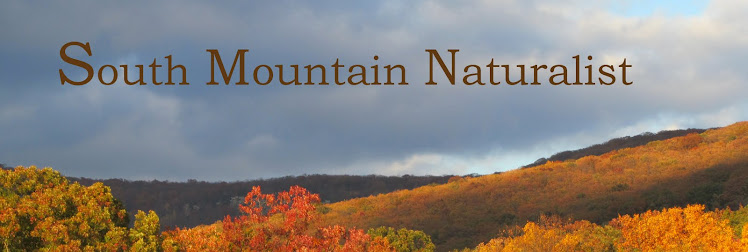This brightly-berried vine is thriving near a grove of pines on the Big Red trail in Greenbrier State Park
A little research identified the vine as Oriental or Japanese Bittersweet, Celastrus orbiculatus, a species brought here fromAsia as a garden ornamental around the time of the Civil War. It became popular because of the profusion of color that persists through the dreary winter months, and perhaps cheered a nation weary of war.
A little research identified the vine as Oriental or Japanese Bittersweet, Celastrus orbiculatus, a species brought here from
Alas, as with so many imported plant species, it has outcompeted our native American Bittersweet, Celatrus scandens, which has many of the same decorative qualities.
The Name Game: Other common names for our native Bittersweet are Climbing Bittersweet, Jacob’s Ladder and Fever Twig! Celastrus derives from kelastros, an ancient Greek name for an evergreen tree. The word
scandens is Greek for trailing or climbing. Orbiculatus refers to the circular shape of the leaf.
C. orbiculatus is a persona non grata for those of us who wish to preserve our native ecosystem. It grows more vigorously and produces more berries than C. scandens. It likes disturbed habitats and can tolerate many different kinds of soil. It chokes out other native vegetation, breaking plants by its excessive weight or shading them out. The older plants of C. orbiculatus can have stems up to 4 inches in diameter. The vine aggressively crawls to the tops of the tallest trees, contributing to uprooting from wind and snow. It can strangle a tree’s roots, cutting off water and nutrients.
C. orbiculatus also has cross-bred with C. scandens, and as a result our native vine has become increasingly rare. Jil M. Swearingen, writing for the National Park Service in 2005, said that C. orbiculatus had been reported as invasive in 21 states and in 14 eastern national parks. With such a negative profile, I find it surprising that Celastrus orbiculatus is still sold and used in the landscaping trade. Especially since there are many native plants that can be easily substituted.
Celastrus orbiculatus is categorized as a woody perennial, and grows both as a climbing vine and a trailing shrub. You will often find it in natural areas near old homesteads. It likes open sun so favors fields and edge habitat, but is shade tolerant so can readily creep into woodlands. The vine can grow by sucker roots, but reproduces and primarily spreads by its seeds. Birds and other wildlife gorge on the berries and carry the seeds far and wide.
Here are the most obvious ways to tell the two plants apart, (assuming one is not examining a hybrid):
Oriental Bittersweet, C. orbiculatus:
Leaf shape: round, about as long as wide
Flowers and fruit: short clusters growing in leaf axils (the upper part of the angle created where the leaf grows out from a stem) many clusters along the stem, clusters are shorter in length than the leaves. Berries more brightly colored than C. scandens.
American Bittersweet, C. scandens:
Leaf shape: About twice as long as wide, tapered at both ends
Flowers and fruit: Single clusters at the tips of stems, clusters about as long as the leaves. Fewer, larger clusters than C. orbiculatus.
I will now keep an eye out for American Bittersweet in the South Mountain environs, including Greenbrier State Park




No comments:
Post a Comment